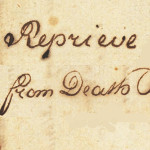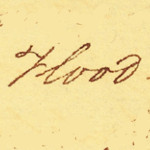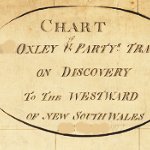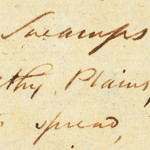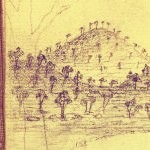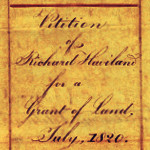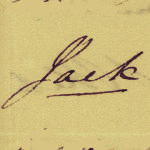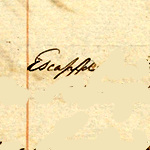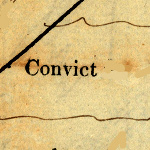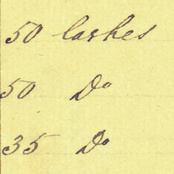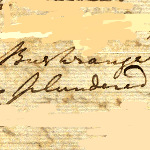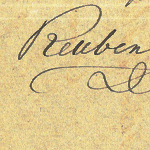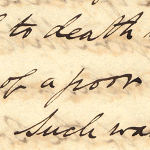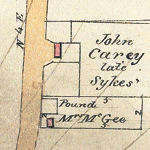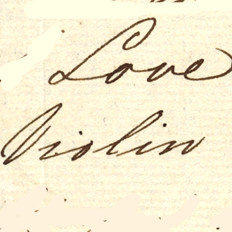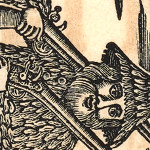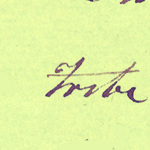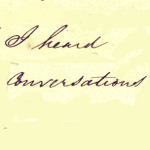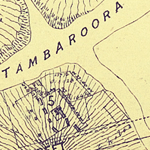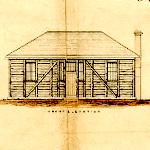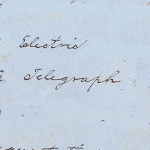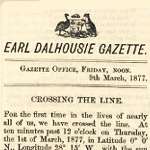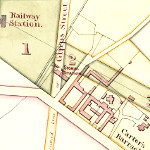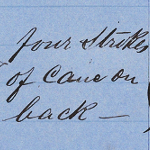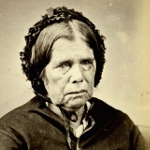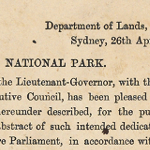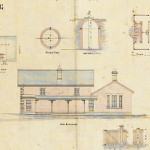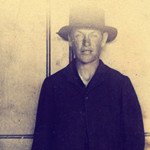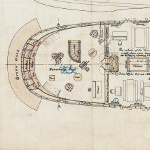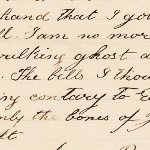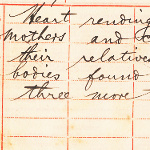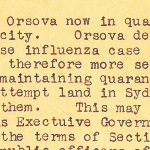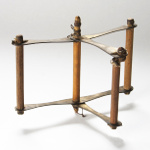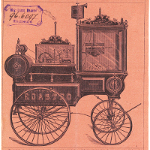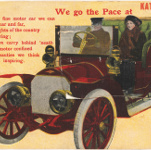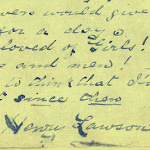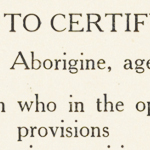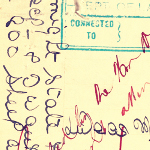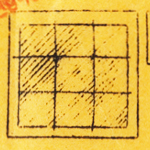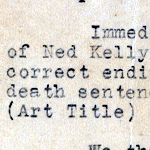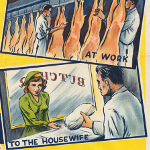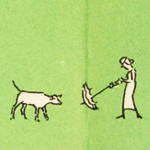50 Years at State Records – an anniversary exhibition
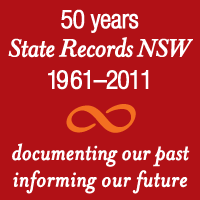 These 50 items from the State archives collection showcase the extraordinary richness and diversity of our holdings, from our ‘founding documents’ recording the convicts on the First Fleet to items from the time of the establishment of the Archives Authority in 1961.
These 50 items from the State archives collection showcase the extraordinary richness and diversity of our holdings, from our ‘founding documents’ recording the convicts on the First Fleet to items from the time of the establishment of the Archives Authority in 1961.
The documents are arranged chronologically in five broad time periods; select a thumbnail below or browse

01. First Fleet Indent
02. A birth on the First Fleet
03. Freedom at a cost – the first pardon granted in 1788
04. Precautions against floods, 1817
05. 1817 Chart – Explorer John Oxley following the Lachlan and Macquarie Rivers
06. An Explorer’s Poem, 1817
07. Journey from Windsor to the north by a ‘gentleman’ convict
08. Request for a grant of land – from the castrator of government stock
09. The murder of an Aboriginal man by a runaway convict, 1820
10. A female escape artist
11. An original Ticket of Leave, 1818
12. Corporal punishment, 1833
13. Bushrangers at large, 1825
14. Reuben Uther, hat maker
15. Sir Thomas Mitchell encounters rural poverty, 1844-45
16. A Publican’s Licence
17. Blind man busking, 1823
18. ‘Professor’ Thomas Rea, ventriloquist
19. Report of the Myall Creek Massacre, 1838
20. A busybody passenger, 1842
21. Reuniting families in the Colony
22. A rough life on the goldfields
23. Designing the prison system
24. The Electric Telegraph
25. Shipboard life – emigration
26. Plans for Central Station, Sydney 1849
27. Punishment at School
28. Nursing advice from Florence Nightingale
29. A life of crime
30. A Royal National Park, 1879
31. Designing the Colony’s court houses
32. Reformatories for wayward boys
33. Refitting ships as reformatories
34. Care of the mentally ill
35. Explosion at Bulli Colliery, 1887
36. Influenza pandemic, 1919
37. Anti-torpedo device, 1888
38. A peanut and popcorn wagon, 1896
39. Adultery and divorce
40. Henry Lawson visits his old school, 1914
41. Government leaks, 1916-1919
42. Aborigines Welfare Board – exemption from regulations
43. Life on the land – a WW1 Returned Soldier
44. Civil unrest in the Great Depression
45. A missing aviator – Charles Kingsford Smith
46. Australian film censorship in the 1920s
47. Are you prepared for the blackout?
48. ‘Meat with care’ – a film
49. Tourism and sightseeing in the 1930s
50. Sydney Opera House
Alternatively, they may be accessed under a number of themes or subjects.
1788-1820
Some of the key themes of this founding era of the Colony’s history are vividly illustrated through extracts taken from the earliest convict and baptismal records, a chart and journal compiled by a little-known convict explorer, a brief but heartfelt poem written by the Surveyor General, and a request for land from an ex-convict with a most unusual occupation.
1820-1850
The 30 years from 1820 to 1850 witnessed the peak and decline of the convict system, the upsurge of free immigration and the continuing expansion of the Colony through exploration and pastoral settlement. A graphic account of floggings and rare original tickets of leave reveal contrasting aspects of convict administration; while the darker side of the expansion of European settlement is vividly illustrated through a letter reporting on the Myall Creek Massacre, and an explorer’s encounter with extreme rural poverty. The records also show the lighter side of colonial life; with a poster promoting the extravagant claims of a visiting ventriloquist, and a revealing account of what really went on ‘below decks’ on an immigrant ship on its way to New South Wales.
1850-1880
The discovery of gold, dramatic increases in immigration, and significant developments in communications technology, education and public health were important themes during the mid-Victorian era in New South Wales. These are reflected in the documents selected; which include a glimpse of crime and punishment on the goldfields at Hill End and Tambaroora, a letter authorising commencement of construction for the electric telegraph, extracts from a newspaper published on board an immigrant ship, advice from Florence Nightingale re the nursing arrangements for Sydney Hospital, a rare and poignant photograph of an Imperial convict in her old age, and minutes of the first meeting of the Board of Trustees for the Royal National Park.
1880-1920
In showcasing documents from this period, we are particularly highlighting one of the great strengths of the collection – the vast array of records documenting the lives of ordinary people, especially their trials and tribulations. Thus we have a wayward lad ‘straightened out’ after a spell on the Nautical School Ship ‘Sobraon’; ‘voices from the asylum’ (letters from psychiatric patients); and a sad tale of adultery and divorce in Erskineville. To lighten the mood, we feature a bizarre proposal for an anti-torpedo device (complete with wooden model); an application to operate a peanut and popcorn wagon; and some testy correspondence about the leaking of confidential government information. Disasters and other momentous events are highlighted through glimpses of the tragic Bulli Colliery explosion of 1887 and the great influenza pandemic of 1918-19; and we have an example of ‘famous people in the archives’, with a little-known poem by Henry Lawson in his own hand.
1920-1961
The fifth and final set of documents covers the period from the end of the First World War to 1961, the year of the establishment of the Archives Authority. This gives us an opportunity to feature records of a number of Government activities that only emerged during the 20th Century. We therefore have correspondence from a hard-working soldier settler battling with the bureaucracy, letters which reveal why the public was not permitted to view ‘unsuitable’ films about bushrangers, and a fascinating audio-visual snapshot of Sydney’s main abattoir complex in 1961. The search for the missing aviator Charles Kingsford Smith is documented in Probate records, and we catch a glimpse of Depression-era Sydney through correspondence about prisoners incarcerated following eviction protests. The exhibition is rounded off with one of the highlights of our 20th Century holdings – Utzon’s original plans and sketches for the Sydney Opera House.
Download
You are welcome to download images from the digital gallery. High resolution copies of digital images can be ordered using the 50th anniversary gallery digital copy order form.
More
Freebies
History
- Historic milestones and events at State Records over the last 50 years
- Published history of archives in New South Wales, by Dr Peter Tyler (PDF, 826kb)


